浅论散打实战比赛中的步法运用
散打体育课教案学习并掌握散打的基本步法

散打体育课教案学习并掌握散打的基本步法一、教学目标1. 让学生了解散打的基本步法及其在实战中的应用。
2. 培养学生协调性、灵活性和反应能力。
3. 提高学生散打技术水平和实战能力。
二、教学内容1. 散打基本步法:直步、侧步、闪避步、跃步、扫步等。
2. 步法训练:步法组合、步法练习、实战演练。
三、教学重点与难点1. 教学重点:散打基本步法的动作要领和实战应用。
2. 教学难点:步法的灵活运用和实战中的变换。
四、教学方法1. 讲解法:教师讲解散打基本步法的动作要领和应用。
2. 示范法:教师示范散打基本步法,学生跟随模仿。
3. 训练法:分组练习,让学生在实战中运用步法。
4. 比赛法:组织学生进行步法比赛,提高实战能力。
五、教学过程1. 课前准备:检查学生穿着合适的运动服和鞋子,确保安全。
2. 课堂热身:进行跑步、跳绳等热身活动,提高学生身体柔韧性和灵活性。
3. 基本步法学习:教师讲解并示范散打基本步法,学生跟随练习。
4. 步法组合训练:学生分组进行步法组合训练,提高步法运用能力。
5. 实战演练:学生分组进行实战演练,运用所学步法进行对抗。
6. 总结与反馈:教师点评学生表现,指出不足之处并进行指导。
7. 课后作业:要求学生回家后练习散打步法,加强巩固。
注意:在教学过程中,教师应密切关注学生的动作质量,及时纠正错误,确保学生掌握正确的基本步法。
要注重培养学生在实战中的应用能力,提高散打技术水平。
六、教学评价1. 评价学生对散打基本步法的掌握程度:观察学生在实战演练中的步法运用是否正确、熟练。
2. 评价学生的协调性、灵活性和反应能力:观察学生在步法训练中的表现,以及能否迅速反应并运用步法应对实战中的变化。
七、教学拓展1. 组织学生参加校内外散打比赛,提高实战能力。
2. 邀请专业散打教练进行课堂教学,丰富学生学习经验。
3. 引导学生观看散打比赛视频,了解散打步法在实战中的应用。
八、安全注意事项1. 确保学生在练习散打步法时,佩戴护具,如手套、护腿、头盔等。
浅论散打实战比赛中的步法运用

浅论散打实战比赛中的步法运用李鸿敏王向阳(洛阳人民警察学校,河南洛阳,471001)摘要:随着武术散打实战技术的提高,比赛中运动员双方对抗日趋紧张激烈,这就要求运动员能充分利用准确快速的移动,来调整双方的有效距离,从而把握比赛的主动权,增强攻、防技术的运用效果。
本文通过对散打运动员的步法在比赛中的技战术运用与研究,以期为散打运动员和广大散打爱好者在日后的训练和比赛提供参考依据。
关键词:武术散打;步法;实战比赛武术散打是一项互以对方技击动作为转移的斗智、较技的对抗性竞赛项目。
也就是双方运动员的手上戴有特别的拳套,在一定规则的限制下,按照所规定的部位进行交锋,并以击中、击倒对方为取胜的运动。
随着比赛水平的提高,在实战中双方运动员为了能轻巧而迅速地移动身体,使自己处于进攻和防守的最佳位置,这就要求运动员必须机动灵活,随机应变地运动步法,并用准确快速的移动步法来调整双方的有效距离,才能在比赛中取得优异成绩。
因此,散打步法的研究是当前广大教练员、运动员极为专注的重要课题。
一、在散打实战比赛中步法的重要性步法是散打技术的重要组成部分。
在实战比赛中,随着双方距离不断的变化,既要不断的出拳、腿攻击对方,还要躲避对方的攻击。
要想在激烈的搏斗中保持身体平衡,且能灵活的移动身体,使自己始终处于进攻和防御的最佳位置。
就必须要熟练地掌握和合理运用好步法,这样可以调整好与对手的距离,为出拳、腿和有力地击中目标创造良好的条件,而且能保持身体重心的平衡。
还可使对方的进攻距离失调,有效地避开对方的来拳,削弱对方的进攻。
不停地、快速地移动,可使对方捉摸不透,增加精神上的压力及负担,阻饶并破坏对方的战术实施,扰乱对方的进攻节奏,从而使自己处于进攻与防御的最有利位置。
掌握与运用好步法技巧可以有效调节自己的情绪和体力,增强观察对手和确定自己实施打击的时间、机会。
还可起到有利使用攻、守时的假动作,打乱对手的阵脚,诱使对手出拳或防御,为更有效地实施战术企图创造条件。
散打步法在实战中的运用及其训练方法的研究

协调能力 。 2 、动作形态:上体保持格斗的基本姿
势,身法 随着 步法做起跳动作步法 以前后 步左右横移步为主。
( 二 )起 蹲练 习
关 键 词 :散 打
步 法 训 练
高 鞭腿 反 击 对 手 的头 部 。当对 手 采 取 踹 腿 打 击我 腹部 时我 可迅 速采用 后退 步后 退 ,同 时趁对手右脚落地的瞬间采用左踹腿反击对 手 ,还 可 以利用 后退 步迅速 后退 ,并 采用 以 左手 拍打对 手右 脚使 其进 攻腿 改变 方 向 ,趁 对 方 右 脚 落 地 的瞬 间 采 用 拳 法 迅速 的进 攻 对 方 ,达到 反击 对 反击对 手 的 目的 。 2 . 1 . 3 、跨 步在 实 战 中的应 用
跨 步躲避对 方来腿 ,同时迅速上步 以左摆
拳 击 打对 手 。 2 . 1 . 4 、交 叉步在 实 战 中的应 用 在 对 抗 中 , 当对 方 以拳 法 或 者 腿 法 进 攻 我 时 ,采 取 左 实 战姿 势 非 常 不 利 于 防 守 和 反击 ,这 就 要 求 左 实战 姿 势 转 换 成 右 实 战 姿 势 进 行 有 效 地 防 守 和 反 击 当 对 方 用 左 鞭 腿 打 击 我 时 我 避 开 对 方 的 打 击 之 后 ,采 取 右 鞭 腿 打 击 对 方 ,如 果 我 采 用 左 实 战 姿 势 很 难 打 击 到 对 方 ,所 以我 可 以迅 速 交 叉 步 换 成 右 实 战 姿 势 打 击 对 方 的 头 部 或 者腹
1 、前言
散 打 , 从 技 术 角 度 看 步 法 是 制 胜 关 键 , 灵 活 的 步 法 可 以 快 速 的 进 行 攻 防 转 换 ,但 无 论 是运 动员 日常训练 过程 当中还 是 散打 教材 中对 散打 步法 的介 绍并不 是非 常 的 多 ,所 以造 成 了许 多散 打运 动员对 步法 并 不
对散打比赛中步法技术运用的研究
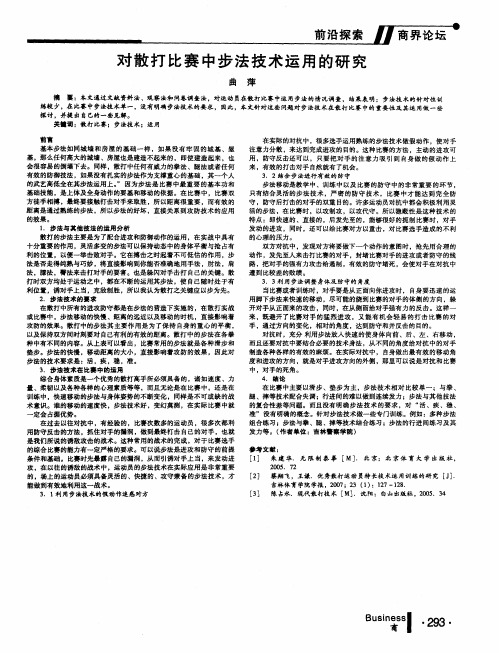
定 会 占据 优 势 。
在过去 以往对抗 中 , 有经 验的 ,比赛次数多 的运 动员 ,很多 次都 利 用防守反击的方法 ,抓住对 手的漏洞 , 做到最终打击 自己的对手 ,也 就 是我们所说 的诱敌攻击 的战术 。这种常用的 战术的完 成 ,对于 比赛选 手 的综合 比赛 的能力有一定严格 的要求 。可 以说步法是进攻 和防守 的前 提 条件和基础 。比赛时先暴露 自已的漏洞 ,从 而引诱对手 上 当,来发 动进 攻 ,在 以往 的诱 敌的战术 中 ,运动员 的步法技术在 实际应用是非 常重要 的。 场上 的运 动员必须具备灵 活的 、快捷 的 、 攻 守兼 备的步法技 术 ,才 能做到有效地利 用这 一战术 。 3 .1利 用步法技 术的假 动作迷 惑对方
对 散 打 比赛 中步 法技 术 运 用 的研 究
曲 萍
摘 要 :本 文通过 文献资料 法、观 察法和 问卷调 查法,对运动 员在散 打比赛中运 用步法 的情 况调查 ,结果表 明:步法技 术 的针对 性训 练较 少,在 比赛 中步法技术单一 ,没有 明确步 法技 术的要 求 ,因此 ,举文针 对这些问题 对步法技术在散 打比赛 中的重要 性及其运 用做 一些
探讨 ,并提 出 自己的一 些见解 。 关键词 :散打 比赛 ;步法技 术;运 用
前 葛
基本步法如 同城 墙 和房 屋的基 础一 样 ,如 果没 有牢 固 的城基 、屋 基 ,那么任何高大的城墙 、房屋也是建造不起来 的,即使 建造起来 ,也 会很容易 的倒塌下去 。同样 ,散打 中任何有威力 的拳法 、腿 法或者任 何 有效的防御技法 ,如果没有扎实的步法作为支撑重心 的基础 ,其一个 人 的武艺高低全在其步法运用上 。 ” 因为 步法是 比赛 中最重要 的基本功 和 基础技能 ,是上体及全身动作 的要基和移动 的依据 。在 比赛中 ,比赛 双 方徒手相搏 ,最终要接触打击对手来取胜 ,所 以距离很 重要 ,而有效 的 距 离是通过熟练的步法 ,所 以步法的好坏 ,直接关系到攻 防技 术 的应 用 的效果。 1 .步法与其他技法的运用分析 散打的步法主要是为 了配合进攻和防御动作的运用 ,在实战 中具有 十分重要的作用 ,灵活多变 的步法可 以保持动态 中的身体 平衡 与抢 占有 利的位置 ,以便一举击败对手 它在搏击之时起着不可低 估的作用 ,步 法是否走得纯熟与巧妙 ,将直接影响到你能否准确地用 手法 ,肘法 ,肩 法 。膝法 ,臀法来击打对手的要害 。也是躲闪对手击打 自己的关键 。散 打时双方均处于运动之 中,都在不断的运用其步法 ,使 自己随时处于有 利位置 ,诱对手上当 ,克敌制胜 ,所 以我认为散打之关键应 以步为先 。 2 .步法技术的耍求 在散打中所有的进攻防守都是在步法 的营造下实施 的 , 在 散打实 战 或 比赛中 ,步法移动的快慢 、距离的远近 以及移动 的时机 ,直接影响 着 攻防的效果。散打 中的步法其 主要作 用是为 了保持 自身的重 心的平衡 , 以及保持双方间时刻要对 自己有利的有效的距离 。散打 中的步法在各拳 种中有不 同的 内 容 。从上表可 以看 出,比赛常用的步法就是各 种滑步 和 垫步。步法的快慢 ,移动距离 的大小 ,直接影响着攻防 的效果 ,因此对 步法的技术要求是 :活 ,疾 ,稳 ,准 。 3 .步法技术在 比赛 中的运用 综合身体素质是一个优秀 的散打高手所必须具备 的 ,诸如速 度、力 量 、柔韧 以及各种各样 的心理素质等等 ,而且无论是在 比赛 中,还是 在 训练 中。快速移动的步法与身体姿势 的不断变化 ,同样是 不可或缺 的战 术意识 。谁的移动 的速度快 ,步法技术好 ,变幻莫测 ,在 实际 比赛 中就
散打的主要动作基本内容

散打的主要动作基本内容一、基本步法步法是散打技术的重要组成部分,在实战中起着重要作用。
常用的步法有滑步、垫步、闪步、换步、交叉步等。
1.滑步:用于快速接近对手或避开对手的攻击,分为前滑步、后滑步、左侧滑步、右侧滑步。
要领是步幅小,速度块,保持身体平衡。
2.垫步:用于在攻击后迅速后撤,为反击做好准备。
要领是后脚先跟进,脚尖着地,保持身体平衡。
3.闪步:用于躲避对手的攻击或突然改变进攻方向。
要领是身体重心迅速移动,保持身体平衡。
4.换步:用于在进攻中变换进攻方向或迷惑对手。
要领是两脚同时用力,快速变换前后位置。
5.交叉步:用于快速移动到对手侧面或后面。
要领是先出一脚,另一脚跟进,不断变换前后位置。
二、基本拳法拳法是散打中最常用的攻击方法之一,常用的拳法有直拳、勾拳、上勾拳、下勾拳等。
1.直拳:最基础的拳法,用于攻击对手面部或胸部。
要领是出拳快而有力,手臂伸直。
2.勾拳:用于攻击对手腹部或侧脸。
要领是转体带拳,手臂弯曲成直角。
3.上勾拳:用于攻击对手下颚或侧脸。
要领是转体带拳,手臂上挑。
4.下勾拳:用于攻击对手心窝或腰部。
要领是转体带拳,手臂向下勾击。
三、基本腿法腿法是散打中威力最大的攻击方法,常用的腿法有正蹬腿、侧踹腿、鞭腿等。
1.正蹬腿:用于攻击对手胸部或面部。
要领是提膝与地面成直角,迅速伸脚尖蹬击对手。
2.侧踹腿:用于攻击对手腹部或膝盖。
要领是转体带腿,脚尖勾起,用脚外侧踹击对手。
3.鞭腿:用于攻击对手腰部或背部。
要领是转体带腿,迅速收腿,用脚背鞭击对手。
四、基本摔法摔法是散打中常用的攻击方法之一,常用的摔法有抱摔、过肩摔等。
1.抱摔:用于抱住对手,使对手无法动弹。
要领是双手抱住对手腰部或腿部,用力推挤。
2.过肩摔:用于将对手从背上摔下。
要领是双手托住对手腰部或腿部,用力向上抛起,然后迅速转身将对手摔下。
五、基本防守防守是散打中重要的技术之一,常用的防守方法有闪避防守、格挡防守等。
1.闪避防守:通过移动身体避开对手的攻击。
论散打实战中步法变化的应用

论散打实战中步法变化的应用作者:杨忠信来源:《山东青年》2014年第07期摘要:步法的变换在散打实战中起着重要的作用,目前一些教练在训练中对步法不够重视,将训练重点放在拳脚的练习上,部分运动员在比赛中因步法的失误,造成整局的败北,而遗憾收场。
本文针对这一情况,加以研究,为中国散打事业做一点绵薄之力。
关键词:散打;实战;步法前言从1979年发展至今武术散打不断的同世界各国进行交流,中泰对抗赛、中美对抗赛、中日对抗赛等,国际中的各种搏击对抗赛基本上都能看到中国散打运动员的身影,可以说武术散打以基本发展成熟。
经过长时间的对外交流与实战,交流对抗中我们发现一个问题,往往一个因为一个小小步法不够灵活、快速而遭对方反攻得手,以至于最后的失利。
武术散打步法作为散打训练中最基本、最简单的技术,也是散打训练、比赛中最重要的内容之一。
武术言语说的好“打拳容易走步难”,如果步法不够灵活的话,打拳必然生乱,如果步法不够快速的话,那么打拳的速度也必然慢了下来。
1.武术散打步法的概述武术言语“先看一步走,后看一伸手”。
步法往往在拳法和腿法之前,步法是拳法和腿法的准备工作。
武术散打步法分为了上步、撤步、滑步、交叉步、闪步五种步法。
这五种不都是练习散打的基础,做起来也比较简单,但真正的在实战中灵活的运用起来就很难了。
往往运动员在实战运动中由于内心的紧张,在加上平时的训练不足或者训练不科学,“造成了步法凌乱或者步法表现单一被对手抓住时机”[1],另外一种情况就是,武术散打实战中,步法与拳法、腿法的协调发力,步法在前进或后退过程中没有很好的衔接好拳法或腿法导致对方得分。
因此,步法的练习和训练应该充分重视起来。
2.武术散打步法的影响因素“散打步法在行进间要求要快速、轻盈灵活、判断准确、落地稳当重心没有前后左右晃动。
”[2]步法的快速这就要求腰部、髋肌、大腿侧肌、大腿骨骼肌、小腿胫肌等肌肉横截面积大,有很好地爆发力。
要做到轻盈灵活,不仅要求全身肌肉骨骼能够在中枢神经系统的指挥下各个器官组织间的协调配合,还要要求膝关节及踝关节有很好地弹性。
浅谈武术散打中步法的重要性
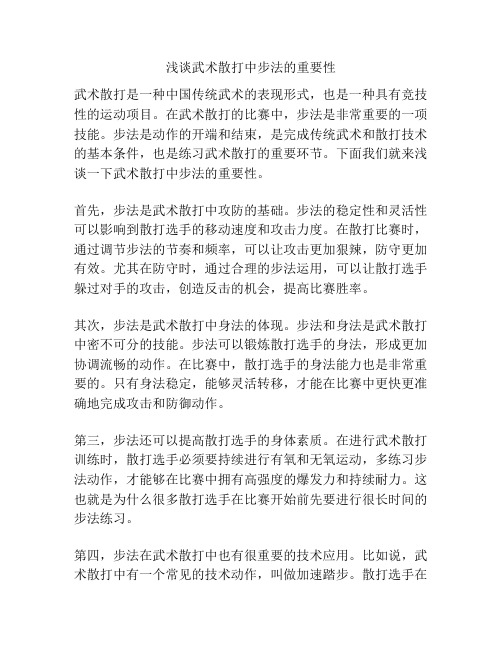
浅谈武术散打中步法的重要性武术散打是一种中国传统武术的表现形式,也是一种具有竞技性的运动项目。
在武术散打的比赛中,步法是非常重要的一项技能。
步法是动作的开端和结束,是完成传统武术和散打技术的基本条件,也是练习武术散打的重要环节。
下面我们就来浅谈一下武术散打中步法的重要性。
首先,步法是武术散打中攻防的基础。
步法的稳定性和灵活性可以影响到散打选手的移动速度和攻击力度。
在散打比赛时,通过调节步法的节奏和频率,可以让攻击更加狠辣,防守更加有效。
尤其在防守时,通过合理的步法运用,可以让散打选手躲过对手的攻击,创造反击的机会,提高比赛胜率。
其次,步法是武术散打中身法的体现。
步法和身法是武术散打中密不可分的技能。
步法可以锻炼散打选手的身法,形成更加协调流畅的动作。
在比赛中,散打选手的身法能力也是非常重要的。
只有身法稳定,能够灵活转移,才能在比赛中更快更准确地完成攻击和防御动作。
第三,步法还可以提高散打选手的身体素质。
在进行武术散打训练时,散打选手必须要持续进行有氧和无氧运动,多练习步法动作,才能够在比赛中拥有高强度的爆发力和持续耐力。
这也就是为什么很多散打选手在比赛开始前先要进行很长时间的步法练习。
第四,步法在武术散打中也有很重要的技术应用。
比如说,武术散打中有一个常见的技术动作,叫做加速踏步。
散打选手在攻击的时候,可以通过蓄力、贴地、弹起,再藉由健康的落地力瞬间发力,形成一次猛烈攻击。
这一技术动作的实现离不开恰当的步伐与腿法技巧。
最后,步法的操作技巧也是非常关键的。
在武术散打比赛中,散打选手需要根据自己强项和对手的技术特点制定合理的步法策略,并且协调运用全身力量,使步法更加灵活自如,达到趋利避害的效果。
总之,步法对于武术散打选手来说是非常重要的。
步法是攻防技能的基础和重要的技术应用,也能够提高身体素质和身法。
对于武术散打选手来说,需要持续进行步法练习,并且注重操作技巧的提高,才能在比赛中更加出色。
当然,对于普通人来说,也可以通过练习武术散打,锻炼自己的身体素质和技能水平,更好地保护自己和他人。
散打实用技法精要

散打实用技法精要
散打是一种实用性极强的武术,其技法涵盖了攻击、防御、控制、应变等方面,适用于各种实际的战斗场合。
以下是散打实用技法的精要:
1.基本站姿:双脚分开与肩同宽,身体保持平衡;身体微向前倾,利于进攻和防守。
2.基本步法:单步、双步、跃步、退步等,可以用于进攻和防守,并可以灵活转换。
3.攻防技巧:包括直拳、勾拳、摆拳、膝击、踢腿等攻击技巧,以及闪避、格挡、拦截等防守技巧,不仅要掌握技巧本身,还要熟练运用。
4.投掷技巧:包括肩摔、臂控、膝撞等,可以有效地控制对手,并且不会造成致命伤害。
5.地面技巧:包括半卧、卧踢、卧掌等,可以在地面上迅速击败对手,并且可以进行固定和控制。
6.应变技巧:针对不同的战斗情况,需要根据实际情况进行应变,适时调整战斗策略和技巧。
总之,散打实用技法的精要在于灵活运用各种技巧,根据实际情况迅速做出应对。
只有熟练掌握这些技法,才能在实际战斗中发挥出最大的战斗力。
- 1 -。
散打的基本技术第一节实战姿势与步法
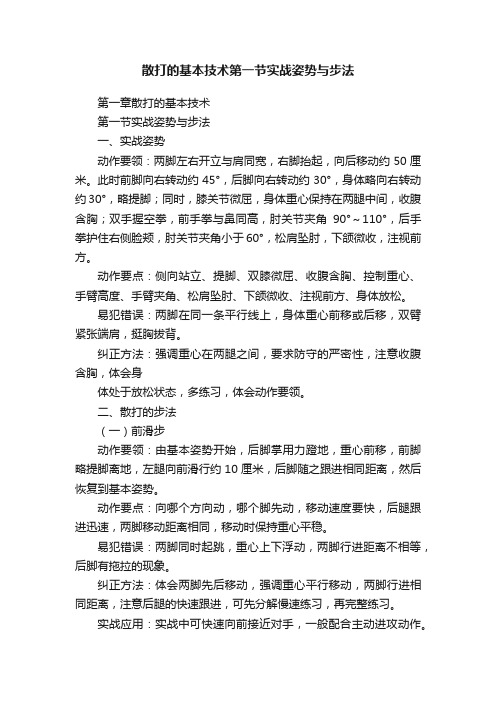
散打的基本技术第一节实战姿势与步法第一章散打的基本技术第一节实战姿势与步法一、实战姿势动作要领:两脚左右开立与肩同宽,右脚抬起,向后移动约50厘米。
此时前脚向右转动约45°,后脚向右转动约30°,身体略向右转动约30°,略提脚;同时,膝关节微屈,身体重心保持在两腿中间,收腹含胸;双手握空拳,前手拳与鼻同高,肘关节夹角90°~110°,后手拳护住右侧脸颊,肘关节夹角小于60°,松肩坠肘,下颌微收,注视前方。
动作要点:侧向站立、提脚、双膝微屈、收腹含胸、控制重心、手臂高度、手臂夹角、松肩坠肘、下颌微收、注视前方、身体放松。
易犯错误:两脚在同一条平行线上,身体重心前移或后移,双臂紧张端肩,挺胸拔背。
纠正方法:强调重心在两腿之间,要求防守的严密性,注意收腹含胸,体会身体处于放松状态,多练习,体会动作要领。
二、散打的步法(一)前滑步动作要领:由基本姿势开始,后脚掌用力蹬地,重心前移,前脚略提脚离地,左腿向前滑行约10厘米,后脚随之跟进相同距离,然后恢复到基本姿势。
动作要点:向哪个方向动,哪个脚先动,移动速度要快,后腿跟进迅速,两脚移动距离相同,移动时保持重心平稳。
易犯错误:两脚同时起跳,重心上下浮动,两脚行进距离不相等,后脚有拖拉的现象。
纠正方法:体会两脚先后移动,强调重心平行移动,两脚行进相同距离,注意后腿的快速跟进,可先分解慢速练习,再完整练习。
实战应用:实战中可快速向前接近对手,一般配合主动进攻动作。
(二)后滑步动作要领:由基本姿势开始,前腿用力向后蹬地,重心后移,后脚略提起,向后伸展滑行约10厘米,当后脚落地后,前脚迅速跟进相同距离,成基本姿势。
动作要点:向哪个方向动,哪个脚先动,移动速度要快,后腿跟进迅速,两脚移动距离相同,移动时保持重心平稳。
纠正方法:两脚同时起跳,重心上下浮动,两脚行进距离不相等,前脚有拖拉现象。
易犯错误:体会两脚先后移动,强调重心平行移动,两脚行进相同距离,注意前腿的快速跟进,可先分解慢速练习,再完整练习。
浅谈散打教学中示范与讲解

浅谈散打教学中示范与讲解散打,是一项集打击、防身、健身于一体的搏击运动,其实质是将人体各部位的致伤手段和防身技术结合起来,通过各种技术动作来进行训练,从而提高自身的格斗能力。
在散打的教学中,示范和讲解是非常重要的环节,它能够帮助学生更好地理解和掌握技术动作,提高训练效果。
本文将就散打教学中的示范与讲解进行一些浅谈。
一、示范的重要性1.直观呈现技术动作散打是一项实战性很强的搏击运动,技术动作的规范与精准至关重要。
在教学中,教练可以通过示范来直观呈现出每一个技术动作的动作要领、姿势要求和动作特点,让学生能够清晰地看到和理解每一个技术细节,从而更好地模仿和学习。
2.激发学生学习的兴趣在教学中,学生往往会对教练的示范动作产生浓厚的兴趣,因为示范是教练对自己所教授的技术的展示,不仅能够让学生感受到教练的实力和专业性,也能够激发学生的学习兴趣,让他们更加投入到训练之中。
3.增强技术的可操作性通过示范,学生可以更加清晰地了解到教练所教的技术是什么样的,这对于学生来说是一种很好的学习方式。
因为当学生看到教练的示范后,他们可以更加明确地了解到每一个动作的细节,增强了动作的可操作性和实践性,让学生在练习时能够更快地领会和掌握技术。
二、讲解的技巧与方法1.语言简单易懂在散打的技术讲解中,语言要求简单易懂,不宜使用过于专业的术语和专业名词,因为学生有可能对这些术语不太熟悉,听不懂会影响学习效果。
教练在讲解时,应该使用通俗易懂的语言,将技术动作的要领和关键点讲解清楚,让学生能够快速地理解和掌握。
2.结合示范进行讲解3.重点突出,层层深入在讲解技术动作时,教练要注意将重点突出,将每一个技术动作的要领、难点和关键点都要讲解清楚,让学生能够明白每一个技术要点和细节。
还要进行层层深入,从简单的技术动作慢慢深入到复杂的技术动作,让学生逐步领会和掌握技术的精髓。
4.注重学生反馈在讲解技术动作时,教练还要注重学生的反馈。
学生有可能会对教练所讲解的技术动作产生一些疑问或者误解,这时就需要教练及时地进行解答和引导,让学生能够更清楚地理解和掌握。
打中拳法与步伐在实战中运用的重要性

1.3 研究现状
直拳是一种直线型攻击的拳法,也有人称之为冲拳,技术动作为向前直线出拳击打对方。拳法是散打运动中的基本技法,而直拳又是散打拳法中的基础,所以说直拳是散打运动中最基本的技术动作。直拳分为两种,一种是左直拳,另一种是右直拳。右直拳的击打力量非常大,配合适当的步伐可以直接进行强有力的进攻,不仅如此,右直拳还能有效化解对手的腿法进攻。直拳学起来相对比较简单,很容易掌握,而且直拳进攻路线比较短,出拳很快,有很强的实用性,因此散打运动员大都能熟练掌握直拳的技巧和使用时机。
1.2 研究内容及意义
本文针对拳法和步伐在散打实战中的应用的重要性做了以下研究,(1)研究了拳法在实战中运用的重要性,这一部分中首先研究了散打中拳法的分类,然后研究了散打中拳法在实战中的运用,最后研究了散打中拳法的训练方法。(2)研究了散打中步伐在实战中的运用的重要性,在这一部分内容中,首先研究了步伐在散打实战中的重要性,然后研究了散打步法在实战中的作用。(3)研究了散打中拳法和步法组合使用的重要性。其中,首先研究了拳法和步伐在实战中的组合运用,然后研究了散打中拳法和步伐的训练方法。
1.4.3 逻辑分析法
根据文献资料内容和对比分析结果,运用逻辑的方法对所得的文献资料进行归纳、推理和总结,提出自己的见解。
1.4.4 调查问卷法
以调查问卷的方式探索人们对散打中拳法和步伐重要性的认识。
2 散打中拳法在实战中运用的重要性
试述步法在青少年散打比赛中的运用

的是 , 当与对 手近身 时 , 可利用步 法快速 的特点 , 迅速 下潜抱 腿 , 运 动员 来说 , 只有基础打好 了, 学习其它技战术才 能得心应手 , 从 当下潜抱腿 成功后 , 可利用后滑步 , 将对 手摔倒 。 生理上 讲 , 青少 年散打运动员机体 已经趋 向成熟 , 爆发力好 , 接受 由此可见 , 步 法在散 打 比赛 中是非常重 要 的 , 运 用 的好与 否 能 力强是青少年散打运动 员机 体已经趋 向成熟 。爆发力好 、 接受 试源自步法在青少年散打 比赛 中的运用
代记新
( 白城市第一 中学体育组吉林省 1 3 7 0 0 0 )
术, 在 泰森面前 快打 、 快撤 , 最后 以点 数取胜 打败 了拳 王泰森 , 在 【 摘要】 根据散打运动的特点, 探讨步法在散打比赛中的运用, 文 章采用 了文献 资料 法 , 观察 法, 进行分析 与研 究 , 在研 究过程 中发 运用游击 战术时 , 一定 要结合 步法快 速的特点 , 在游击 中打败对 现, 步 法在 散打 比赛 中确 实起 到 至关重要 的作用 , 尤其 是在 劣势 手 。
的局 面下 , 通过调 整步 法, 合 理地分 配体力 可以达到反 败为胜 的 第三、 步法在迂 回战术中 的运用 。迂 回战术指利 用步法从不 目的 , 得 出结论 : 在散 打比赛 中 , 若能灵 活的运 用步法 , 并合理 地 同角度 向对 手进行攻 击 , 步法 中“ 准确 , 稳定 ” 的特点在 迂 回战术
锋利 的武器 , 现代散 打 比赛中 , 步法 在运用时一定要 突出准确 、 灵 攻 , 在游击 中得点加分 , 使刘宪法伟 没有 占到任何便宜 , 消耗 了很 活、 稳定 、 快 速等特 点 , 准确 即步法移动 的距离要 适 当, 拳腿 摔技 大体 能 , 第二 局也 是如 此 , 到 了第 三局 , 格 日乐 图利 用 多变 的步
散打比赛中运动员拳、腿组合技术步法的运用

散打比赛中运动员拳、腿组合技术步法的运用作者:潘晓萌来源:《体育时空》2014年第01期中图分类号:G852.4 文献标识:A 文章编号:1009-9328(2014)01-000-01摘要通过文献资料法、专家访谈法和逻辑分析法了解到目前有关于散打步法的研究很少,运动员步法技术运用缺少系统性,表现在步法变化单一、僵滞,与其它技术动作配合失调。
针对上述出现的问题,本文从论述步法在散打比赛拳、腿组合中的运用,来探索比赛中拳、腿这种连击组合对步法的需求,脚掌助推力充分利用的重要作用和心理素质对步法运用的影响作用,从而希望为解决步法技术中存在的不足、为培养技术型散打运动员提供理论指导。
关键词步法运动员比赛影响一、研究对象对散打比赛中运动员步法作用的分析。
二、研究与分析(一)散打比赛中步法的稳定性从把握移步的距离到保持身体中心的平稳来看,最终目的都是为了说明步法稳定性的重要作用。
所以,在练习步法时,要求运动员要有恒心,有耐心,有决心。
在教练员这一方面要认真总结经验,合理安排时间,结合实际情况,循序渐进,有针对性地运用科学的、系统的方法指导运动员的练习,让每一位运动员都能在赛场上展现熟练、稳定的散打步法。
1.把握上步的距离。
在比赛中运动员移动步幅影响着身体的平衡,步幅的大小无疑是关键的。
步幅大了难以控制自身的重心及动作的质量,在进攻时很容易被对手反击,特别是在进攻出高鞭腿时极容易被对方向上推、掀摔倒。
在拳、腿组合中也容易造成浪费力气,让对手近身反击。
步幅小了,达不到进攻的目的,难以准确击中对手,容易让对手使用接触性防守动作进行防守反击。
因此只有掌握好与对手的距离,控制好步幅,配合好拳、腿组合技术,虚实结合,以拳虚晃,实则重腿在后,从而更好的达到进攻的目的。
2.要把握上步的方向。
移步的方向对运动员控制自己的重心及把握战机来说是非常重要的。
步法移动的方向能否与进攻或防守密切配合,协调一致,不仅影响着身体的重心的稳定,更重要的是会失去战机或导致被动挨打。
散打的基本步法与拳法

散打的基本步法与拳法散打的基本步法与拳法散打是一项徒手搏击格斗的技术,下面是店铺分享的散打的基本步法与拳法,一起来看一下吧。
基本步法散打步法是为保持与对手间的距离,实施进攻与防守动作或破坏对手与进攻与防守意图,而进行专门的脚步移动方法,步法好多,比如滑步、垫步等等。
1、滑步。
前滑步:实战势,后脚蹬地,前脚向前移动,落地时以前脚掌先落地,随之后脚前移,落地后与原基本姿势相同。
后滑步:反之。
2、左滑步:实战势,后脚蹬地,前脚向左平移,后脚随之向左移动,作完成后与原实战势相同。
右滑步反之。
3、垫步:前垫步:实战势,前脚蹬地,后脚前移,在前脚里侧处落地的同时前脚前移,落步后仍成原基本姿势。
后垫步:实战势,后脚蹬地,前脚后移,在前脚里侧落地的'同时后脚后移,落步后仍成基本姿势,变换要快,两腿不可交,叉垫步时身体重心要求两脚贴近地面滑行。
基本拳法拳法主要技法有:直拳、勾拳、摆拳,其中还演变出刺拳,鞭拳等技法。
1、左右直拳左直拳:基本实战势站立,左脚在前右脚在后,左脚跟稍外转,重心移至左脚,上体略左转,同时,左臂顺肩伸肘,使拳面向前直线冲击,力达拳面,拳心朝下,右拳至下额处,目视前方,然后左拳压肘收回,成基本姿势。
右直拳反之。
要点:要使蹬地,拧腰之力顺达拳面,整个动作要协调完整,重心不可过多前倾,击打部位的高低区别于左膝度,击拳前不可出现先收拳再击的预兆,也不可在冲拳时将右臂后拉,结合步法的击法应做到拳到步到。
右直拳:要与右脚蹬地拧腰转体的力完整一致,从而获得最大的冲力,身体重心要在冲拳的同时前移,不可提前,左拳不要下垂或外张。
2、左右摆拳左摆拳基本实战势,右脚蹬地,身体重心移向左脚,左脚跟略离地外转并辗转脚掌,上体右转同时左臂内旋,抬肘与肩平,使拳由左向右横击高于肩平,然后恢复基本姿势。
右摆拳反之。
要点:摆拳时身体不可向右倾斜,要边击拳边抬肘,击打后重心偏左脚,左脚的辗转力不可忽视,要含胸收腹,不可低头。
浅谈武术散打中步法的重要性

浅谈武术散打中步法的重要性武术散打是一种以实战为目的的武术运动,其技术主要包括拳、腿、手、肘、膝等多种攻击手段。
而在进行这些技术时,步法的运用显得尤为关键。
步法的好坏不仅直接影响到整个人的姿势,还会直接影响到战术运用的效果。
本文将分享关于浅谈武术散打中步法的重要性的观点和经验。
一、步法的基本要求在武术散打中,步法的基本要求主要体现在以下三个方面:1、稳固性稳固性是武术散打中最为基础的要求之一。
只有脚步牢固,身体才能稳定。
稳定的身体能够更好地发挥技术特点,也更容易进行攻防转换,从而在比赛中更有优势。
2、轻快性轻快的步法在武术散打中尤为重要。
轻快的步法不仅使得运动员能够更好地躲避对手的攻击,还能在瞬间转换自己的攻击角度,从而给予对手重击。
3、灵活性灵活性是武术散打步法的另一重要要求。
运动员应该具有很高的运动灵活性,能够在不停降低速度的情况下快速掌握步伐。
二、武术散打中常见的步法武术散打中常见的步法有:1、平移步平移步属于基础步法之一,顾名思义就是将脚步向前或向后移动而不改变脚的方向,这样可以改变自己的位置,同时可以阻挡对手的攻击。
2、横移步横移步亦属于武术散打的基础步法之一,适用于在不改变自己的位置的情况下,改变脚的方向以切换攻击位置。
3、弧形移步弧形移步是在较长距离内移动时的一种步法,可以增加运动员的灵活性,此时需要脚底和地面接触到的面积尽量小,保持身体的重心稳定。
4、转移步转移步是一种常用的反制步法,可以在一瞬间远离对手,同时可以借此机会反击对手。
需要注意的是,在使用转移步时需要速度快、移动距离短、稳定性好等要求三、如何训练步法1、常规步法练习一般来说,常规的步法训练需要在木桩上进行,首先需要根据自身身高和臂展长度选择合适的木桩。
之后,站在木桩前,做出一个初始的步步姿态,然后以一定的速度前进,完成对手的攻击。
2、推手对练推手对练是武术散打中非常重要的一种训练方式。
这种方式可以帮助运动员在训练中不断实践步法,例如维持平衡、转移步法。
浅谈武术散打中步法的重要性
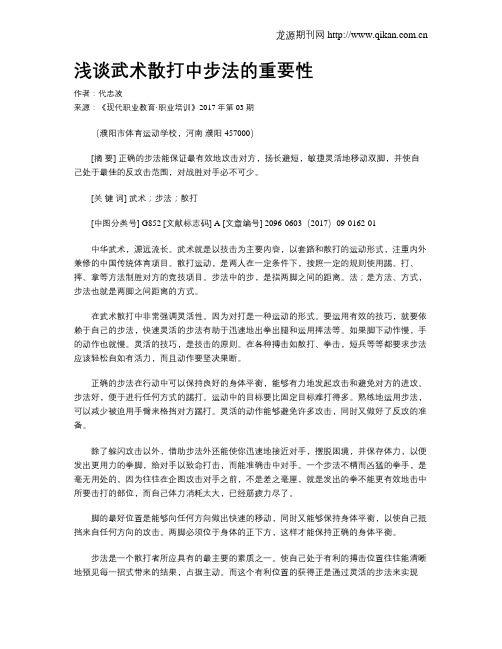
浅谈武术散打中步法的重要性作者:代忠波来源:《现代职业教育·职业培训》2017年第03期(濮阳市体育运动学校,河南濮阳 457000)[摘要] 正确的步法能保证最有效地攻击对方,扬长避短,敏捷灵活地移动双脚,并使自己处于最佳的反攻击范围,对战胜对手必不可少。
[关键词] 武术;步法;散打[中图分类号] G852 [文献标志码] A [文章编号] 2096-0603(2017)09-0162-01中华武术,源远流长。
武术就是以技击为主要内容,以套路和散打的运动形式,注重内外兼修的中国传统体育项目。
散打运动,是两人在一定条件下,按照一定的规则使用踢、打、摔、拿等方法制胜对方的竞技项目。
步法中的步,是指两脚之间的距离。
法;是方法、方式,步法也就是两脚之间距离的方式。
在武术散打中非常强调灵活性。
因为对打是一种运动的形式。
要运用有效的技巧,就要依赖于自己的步法,快速灵活的步法有助于迅速地出拳出腿和运用摔法等。
如果脚下动作慢,手的动作也就慢。
灵活的技巧,是技击的原则。
在各种搏击如散打、拳击,短兵等等都要求步法应该轻松自如有活力,而且动作要坚决果断。
正确的步法在行动中可以保持良好的身体平衡,能够有力地发起攻击和避免对方的进攻。
步法好,便于进行任何方式的踢打。
运动中的目标要比固定目标难打得多。
熟练地运用步法,可以减少被迫用手臂来格挡对方踢打。
灵活的动作能够避免许多攻击,同时又做好了反攻的准备。
除了躲闪攻击以外,借助步法外还能使你迅速地接近对手,摆脱困境,并保存体力,以便发出更用力的拳脚,给对手以致命打击,而能准确击中对手。
一个步法不精而凶猛的拳手,是毫无用处的。
因为往往在企图攻击对手之前,不是差之毫厘,就是发出的拳不能更有效地击中所要击打的部位,而自己体力消耗太大,已经筋疲力尽了。
脚的最好位置是能够向任何方向做出快速的移动,同时又能够保持身体平衡,以使自己抵挡来自任何方向的攻击。
两脚必须位于身体的正下方,这样才能保持正确的身体平衡。
散打基本步法解析及练习方法
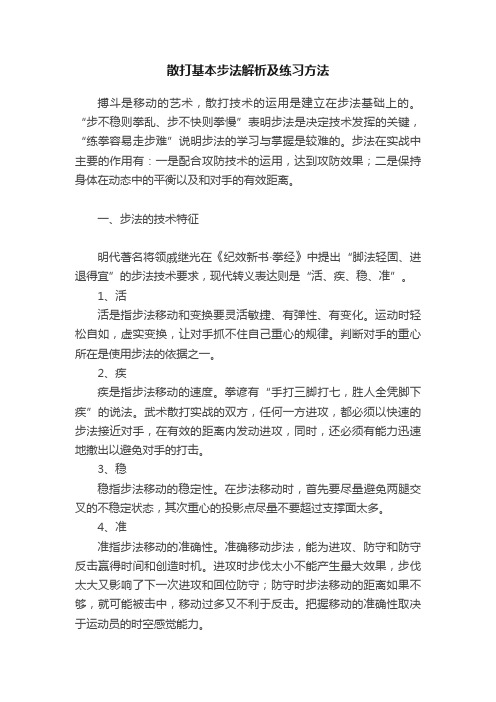
散打基本步法解析及练习方法搏斗是移动的艺术,散打技术的运用是建立在步法基础上的。
“步不稳则拳乱、步不快则拳慢”表明步法是决定技术发挥的关键,“练拳容易走步难”说明步法的学习与掌握是较难的。
步法在实战中主要的作用有:一是配合攻防技术的运用,达到攻防效果;二是保持身体在动态中的平衡以及和对手的有效距离。
一、步法的技术特征明代著名将领戚继光在《纪效新书·拳经》中提出“脚法轻固、进退得宜”的步法技术要求,现代转义表达则是“活、疾、稳、准”。
1、活活是指步法移动和变换要灵活敏捷、有弹性、有变化。
运动时轻松自如,虚实变换,让对手抓不住自己重心的规律。
判断对手的重心所在是使用步法的依据之一。
2、疾疾是指步法移动的速度。
拳谚有“手打三脚打七,胜人全凭脚下疾”的说法。
武术散打实战的双方,任何一方进攻,都必须以快速的步法接近对手,在有效的距离内发动进攻,同时,还必须有能力迅速地撤出以避免对手的打击。
3、稳稳指步法移动的稳定性。
在步法移动时,首先要尽量避免两腿交叉的不稳定状态,其次重心的投影点尽量不要超过支撑面太多。
4、准准指步法移动的准确性。
准确移动步法,能为进攻、防守和防守反击赢得时间和创造时机。
进攻时步伐太小不能产生最大效果,步伐太大又影响了下一次进攻和回位防守;防守时步法移动的距离如果不够,就可能被击中,移动过多又不利于反击。
把握移动的准确性取决于运动员的时空感觉能力。
二、基本步法解析散打基本步法主要有前进步、后退步、收步、上步、进步、退步、插步、垫步、纵步、闪步、换步等。
1、前进步动作要领:由实战姿势开始,后脚蹬地,前脚向前进半步,后脚紧接跟进半步,移动的步幅稍大于肩距,身体重心始终保持在两腿之间(图1-3)。
2、后退步动作要领:由实战姿势开始,左脚掌蹬地,右脚稍离地面向后滑行20~30厘米,左脚随即后滑一步,保持基本姿势(图4-6)。
3、收步动作要领:由实战姿势开始,左脚向后收步至右脚旁,脚掌点地,重心偏于右腿(图7、8)。
散打实战步伐训练教案
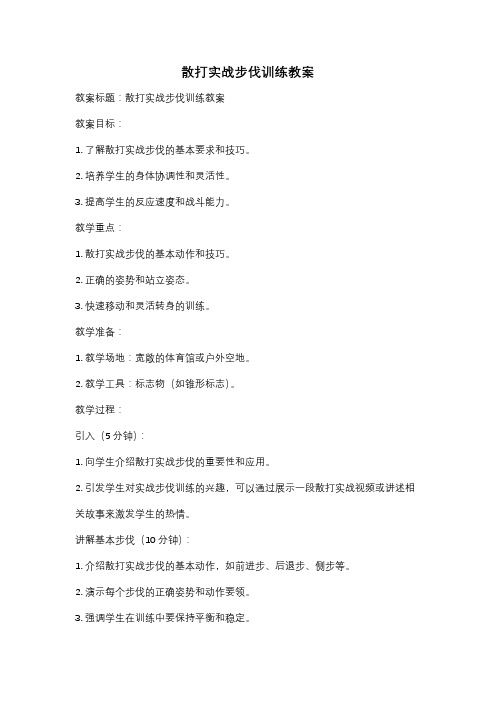
散打实战步伐训练教案教案标题:散打实战步伐训练教案教案目标:1. 了解散打实战步伐的基本要求和技巧。
2. 培养学生的身体协调性和灵活性。
3. 提高学生的反应速度和战斗能力。
教学重点:1. 散打实战步伐的基本动作和技巧。
2. 正确的姿势和站立姿态。
3. 快速移动和灵活转身的训练。
教学准备:1. 教学场地:宽敞的体育馆或户外空地。
2. 教学工具:标志物(如锥形标志)。
教学过程:引入(5分钟):1. 向学生介绍散打实战步伐的重要性和应用。
2. 引发学生对实战步伐训练的兴趣,可以通过展示一段散打实战视频或讲述相关故事来激发学生的热情。
讲解基本步伐(10分钟):1. 介绍散打实战步伐的基本动作,如前进步、后退步、侧步等。
2. 演示每个步伐的正确姿势和动作要领。
3. 强调学生在训练中要保持平衡和稳定。
实践训练(30分钟):1. 将学生分成小组,每组站在一个起点位置。
2. 在场地上设置一些标志物,让学生按照指令依次完成前进、后退和侧步等步伐。
3. 强调学生在训练中要保持动作的流畅和准确性。
4. 每个小组进行多次练习,逐渐增加难度和速度。
巩固练习(10分钟):1. 让学生自由组合各种步伐进行训练,以提高他们的反应速度和战斗能力。
2. 观察学生的动作并给予适当的指导和纠正。
总结(5分钟):1. 回顾今天的教学内容,强调散打实战步伐的重要性和训练效果。
2. 鼓励学生在日常生活中继续练习和运用所学到的步伐技巧。
教案扩展:1. 可以引入散打实战技巧的训练,如打拳、踢腿等。
2. 可以组织学生进行模拟实战训练,提高他们的实战能力和应变能力。
教案评估:1. 观察学生在训练中的表现,包括动作的准确性、速度和流畅性。
2. 给予学生反馈和指导,帮助他们改进和提高。
注:教案仅供参考,具体教学内容和方法可根据实际情况进行调整。
- 1、下载文档前请自行甄别文档内容的完整性,平台不提供额外的编辑、内容补充、找答案等附加服务。
- 2、"仅部分预览"的文档,不可在线预览部分如存在完整性等问题,可反馈申请退款(可完整预览的文档不适用该条件!)。
- 3、如文档侵犯您的权益,请联系客服反馈,我们会尽快为您处理(人工客服工作时间:9:00-18:30)。
摘要:
散打运动来源于中国武术,也是中国传统文化的重要组成部分。
近年来随着人们生活水平的提高和对散打认识的提高,越来越多的人开始学习散打。
在散打的技术动作当中,拳法是快速而且非常有效的得分手段,而且是最容易掌握的技术手段,步法是散打技术中的重要内容,直接影响着运动员在比赛中攻防技术的发挥。
散打中拳法和步伐在实战中都有重要作用。
本文通过对散打运动中拳法和步伐在实战中的应用研究,强调了散打实战中拳法和步伐以及二者组合使用的重要性,有助于提高散打运动员和散打爱好者对拳法和步伐重要性的认识,对日后关于拳法和步伐在散打实战中的重要性相关理论研究提供一定的参考。
关键词:散打;拳法;步伐
Abstract:
Free combat is derived from Chinese martial arts and is an important part of Chinese traditional culture. In recent years, with the improvement of people's living standards and the improvement of Free combat awareness, more and more people began to learn Free combat. In the technical action of Free combat, the boxing method is a fast and very effective scoring method, and it is the easiest technical means to master. The footwork is an important part of Free combat technology, which directly affects the athletes' offensive and defensive techniques in the game. The boxing method and pace of Free combat play an important role in actual combat. Through the application of the boxing method and pace in Free combat exercise in actual combat, this paper emphasizes the importance of the boxing method and pace in Free combat combat and the combination of the two, which helps to improve the importance of Free combat athletes and Free combat fans on the boxing and pace. Cognition, provide some reference for the theoretical research on the importance of boxing and pace in the actual combat of Free combat in the future.
Key words:Free combat; Boxing;Footwork
目录
摘要: (1)
Abstract: (2)
1 研究背景及意义 (5)
1.1 研究背景 (5)
1.2 研究内容及意义 (5)
1.3 研究现状 (6)
1.4 研究方法 (6)
1.4.1 文献调研法 (6)
1.4.2 对比分析法 (6)
1.4.3 逻辑分析法 (7)
2 散打中拳法在实战中运用的重要性 (7)
2.1 散打中拳法的分类 (7)
2.2 散打中拳法在实战中的运用 (7)
2.3 散打中拳法的训练方法 (8)
3 散打中步伐在实战中运用的重要性 (9)
3.1 散打步伐在实战中的重要性 (9)
3.2 散打中步伐在实战中的作用 (9)
4 散打中拳法与步伐组合使用的重要性 (10)
4.1 拳法与步伐在实战中组合运用的重要性 (10)
4.2 拳法和步伐组合技术的训练 (10)
5 结论与建议 (12)
5.1 结论 (12)
5.2 建议 (12)
参考文献 (13)
致谢 (1)
附录: (2)。
